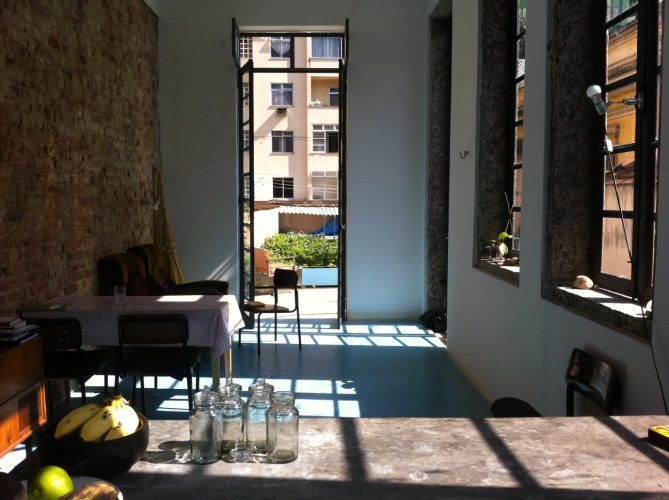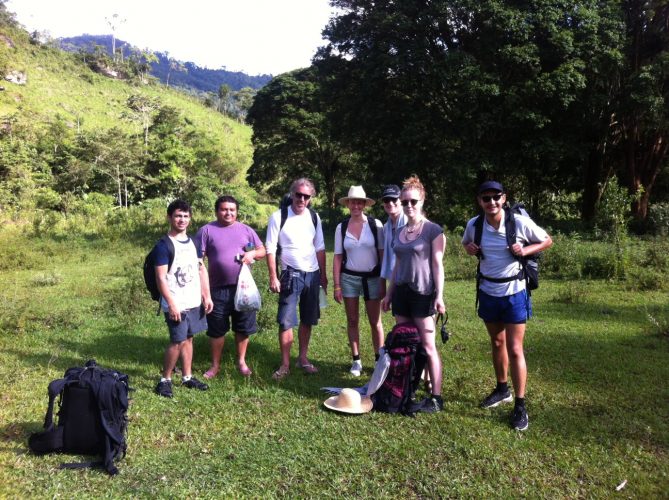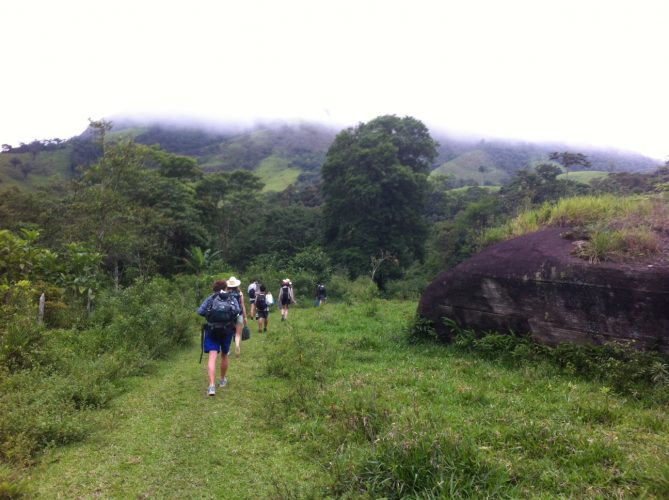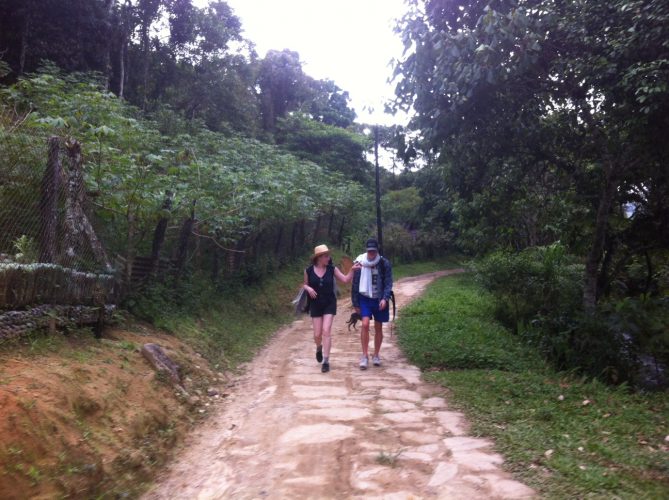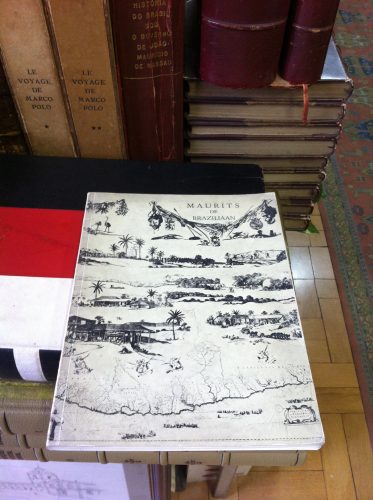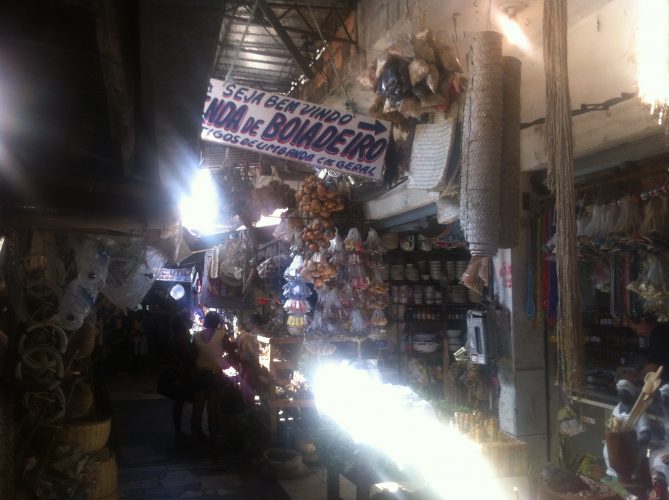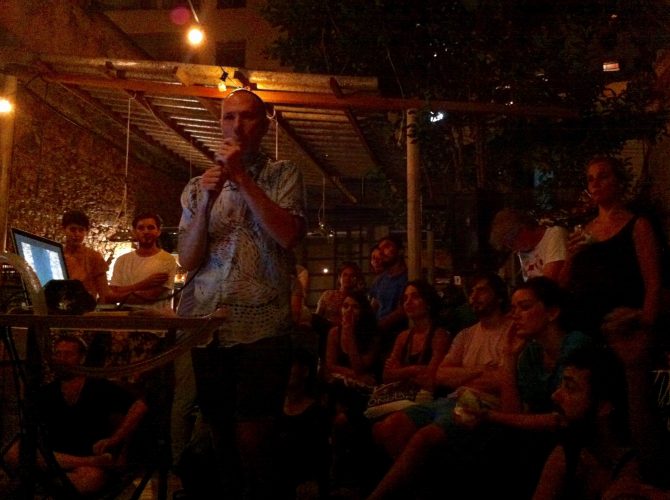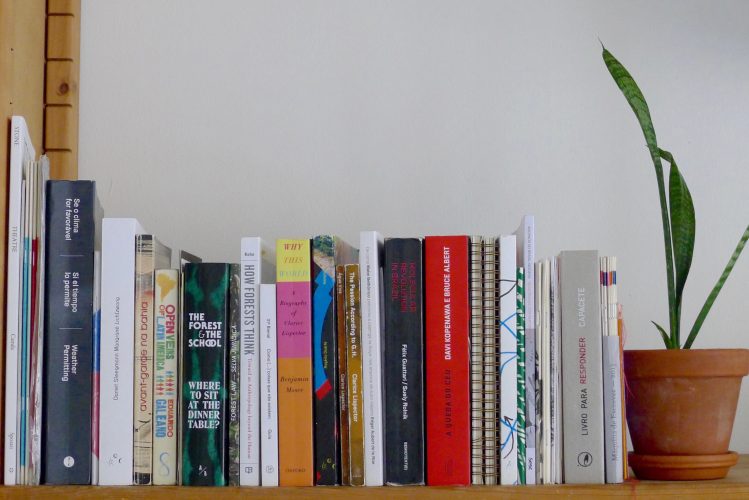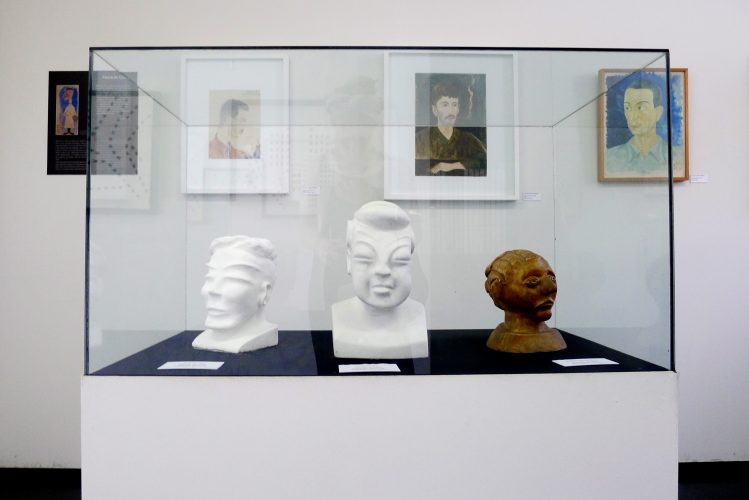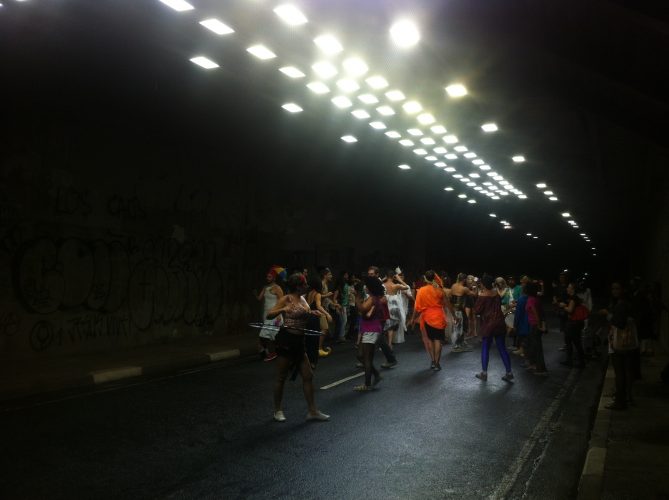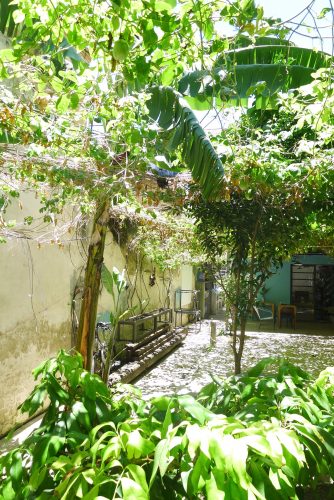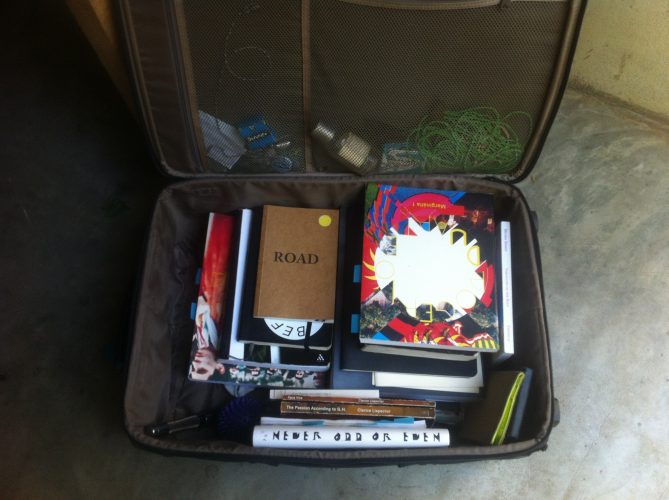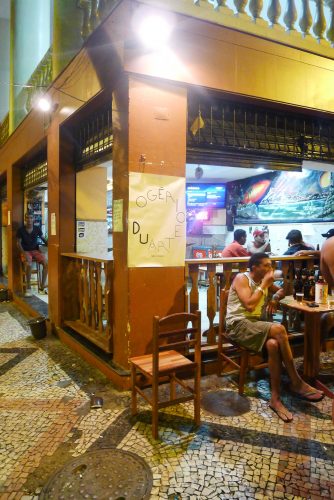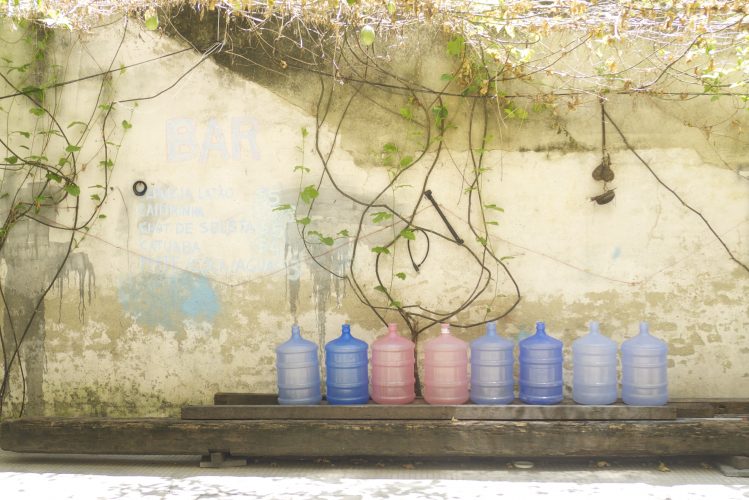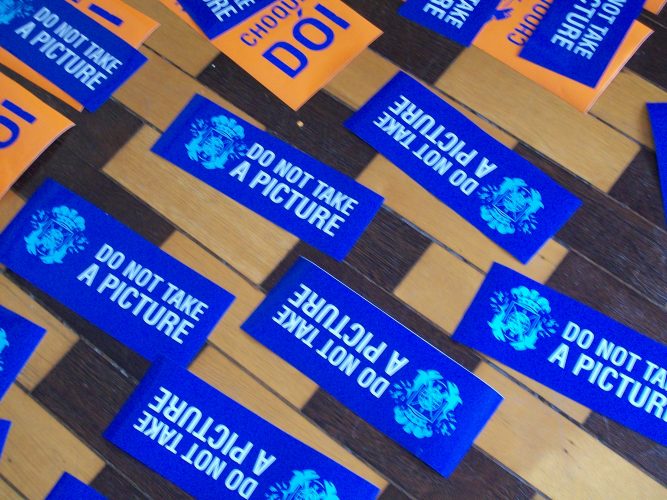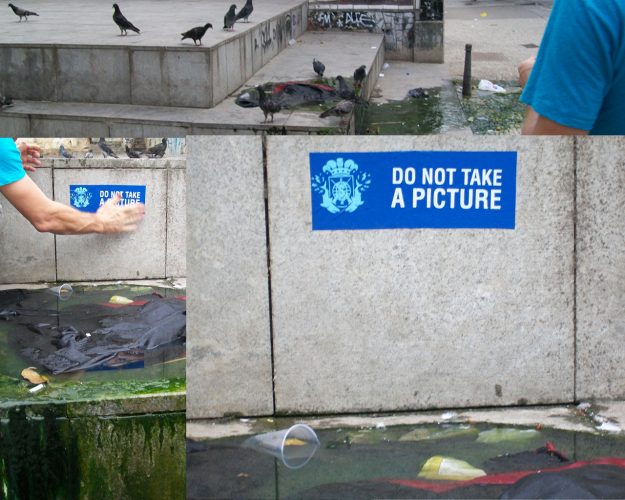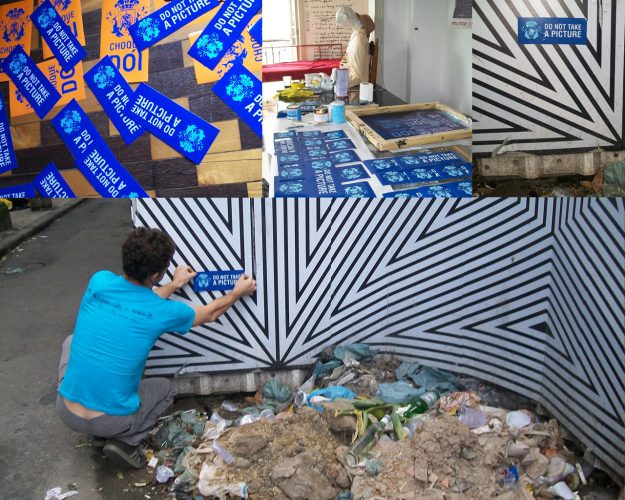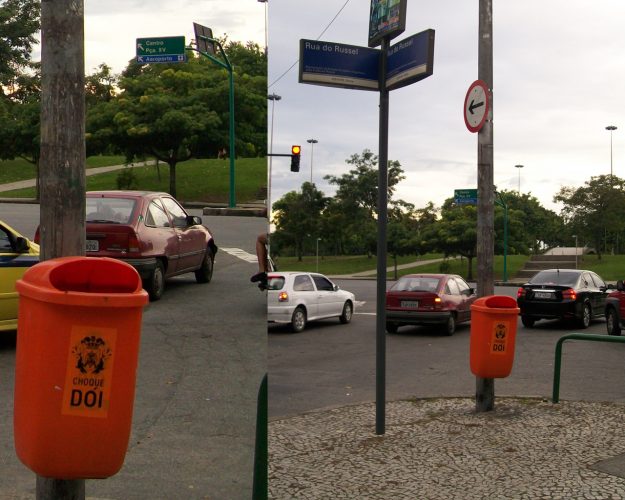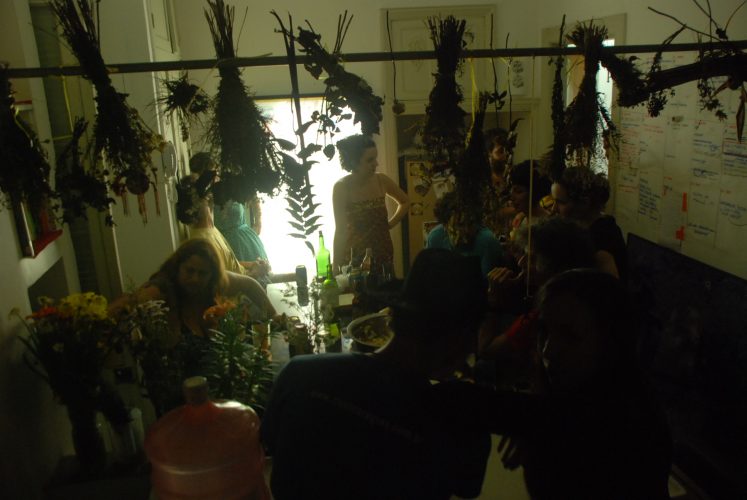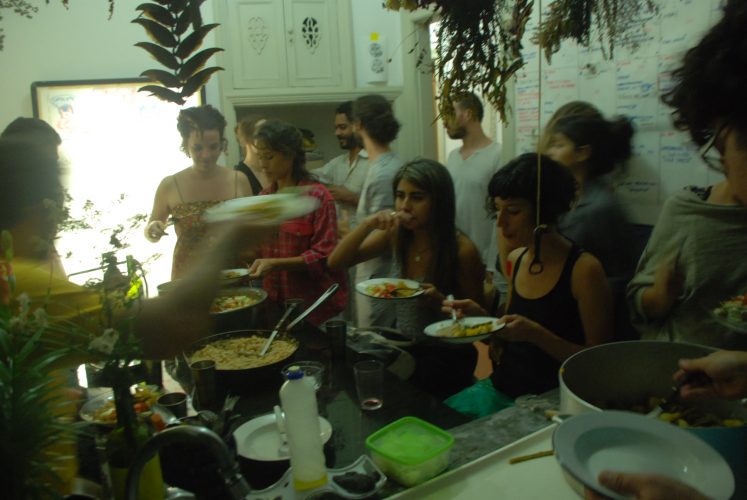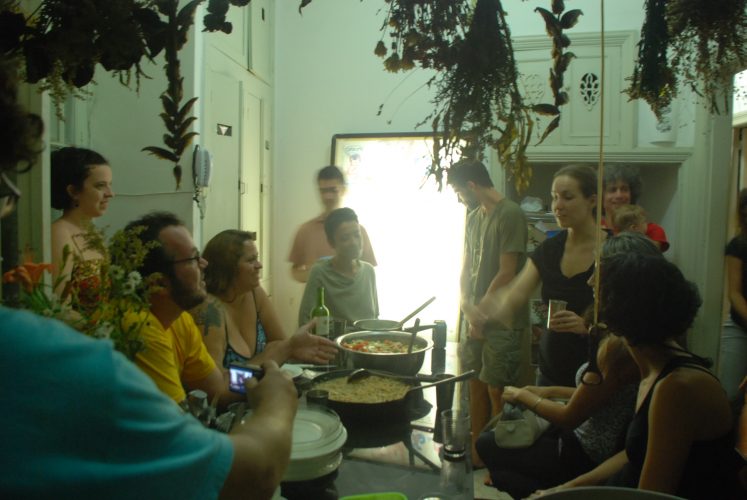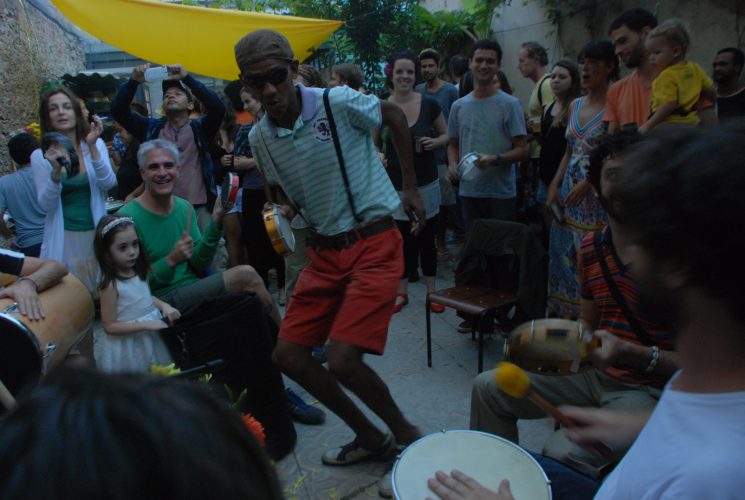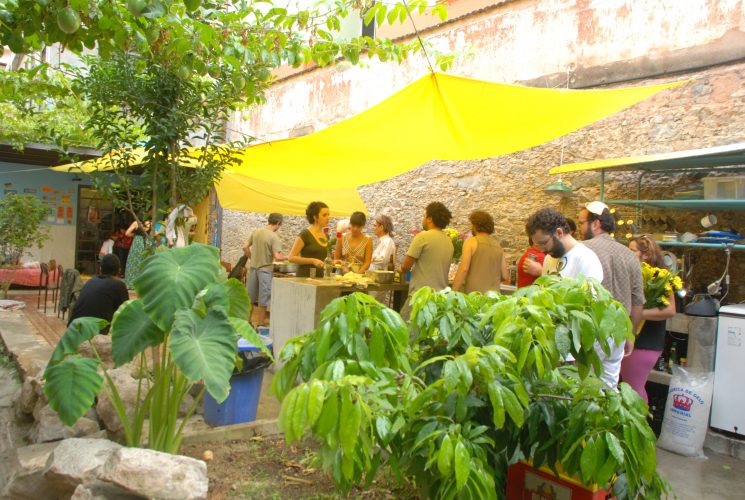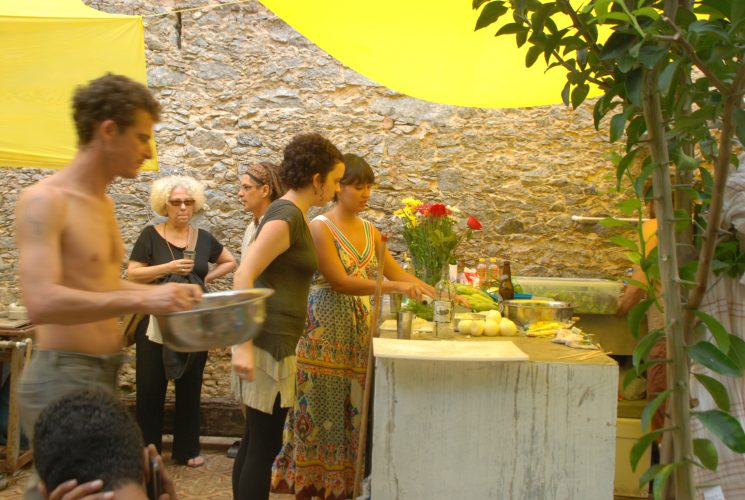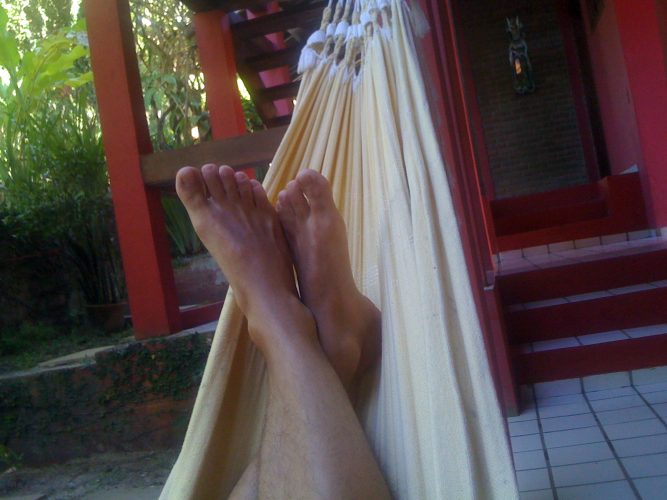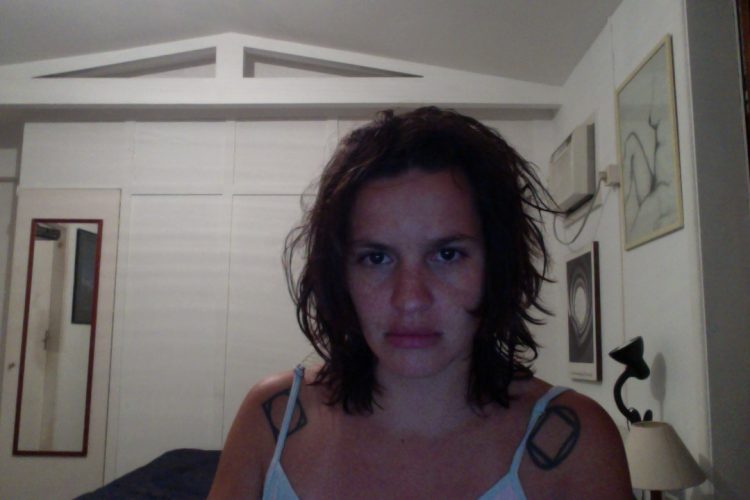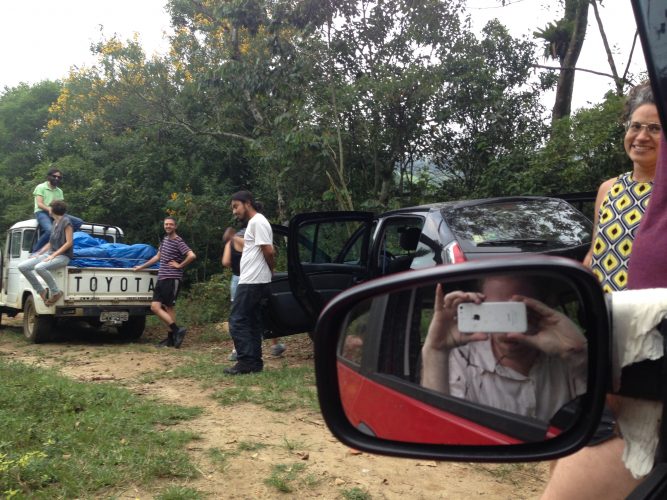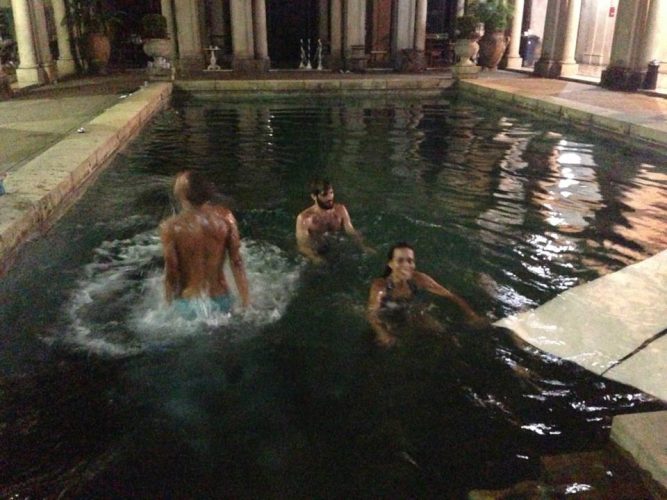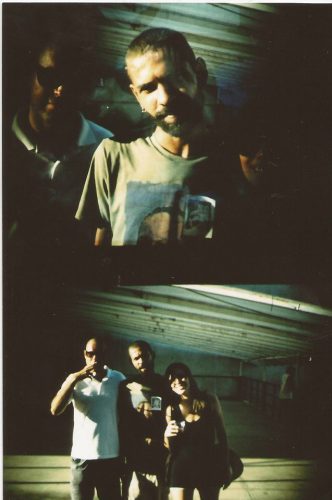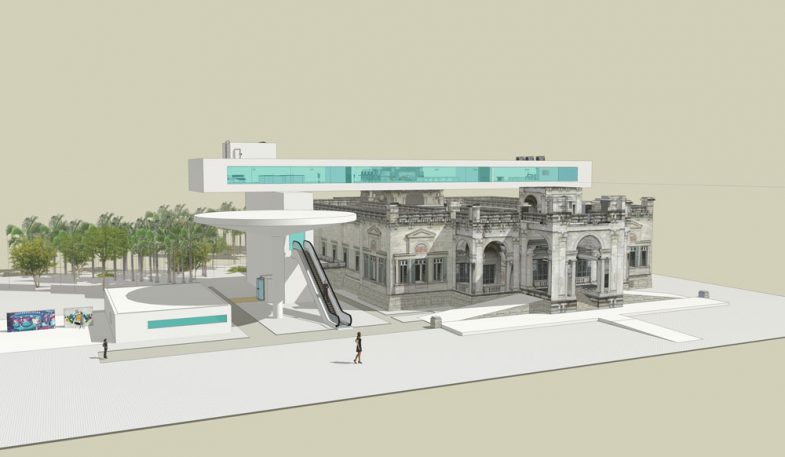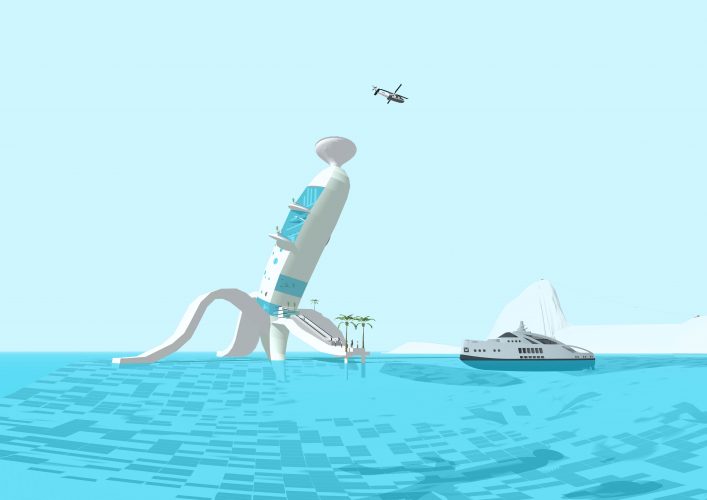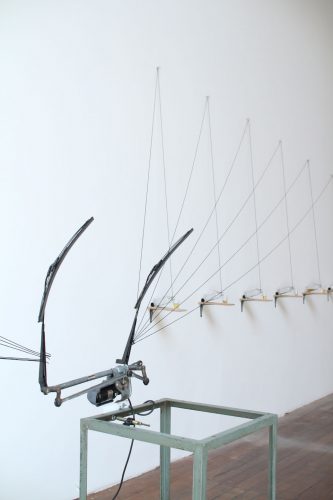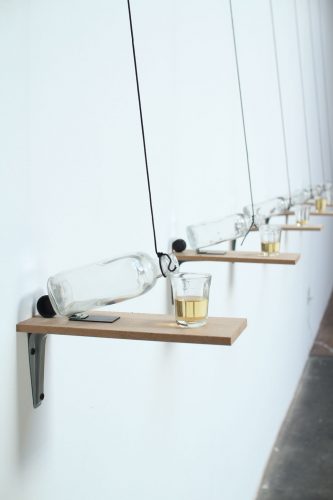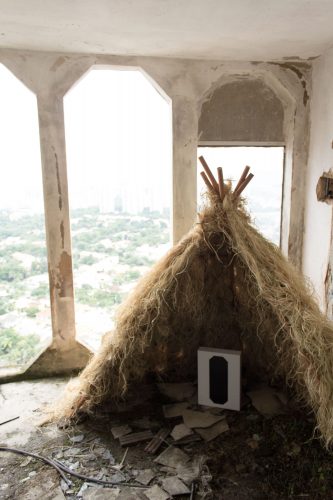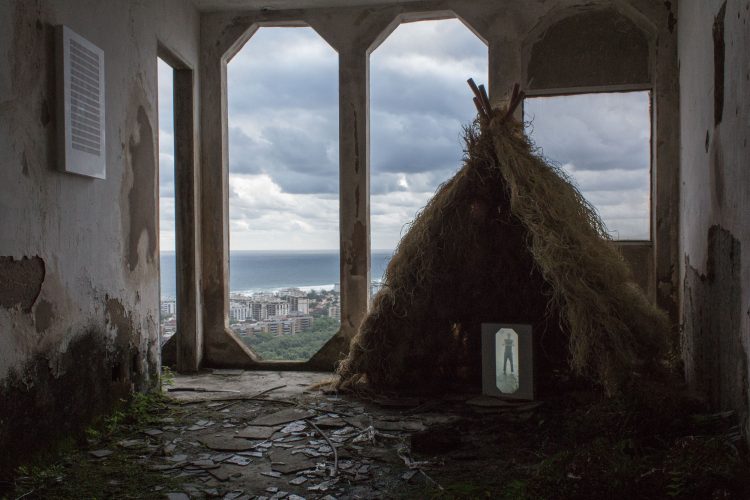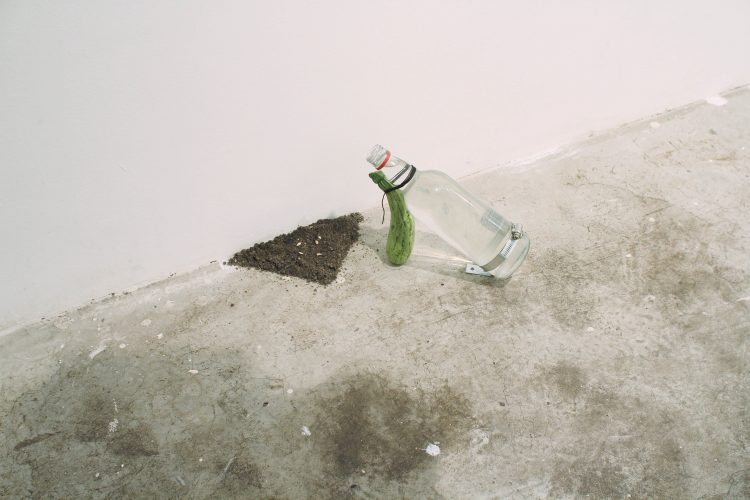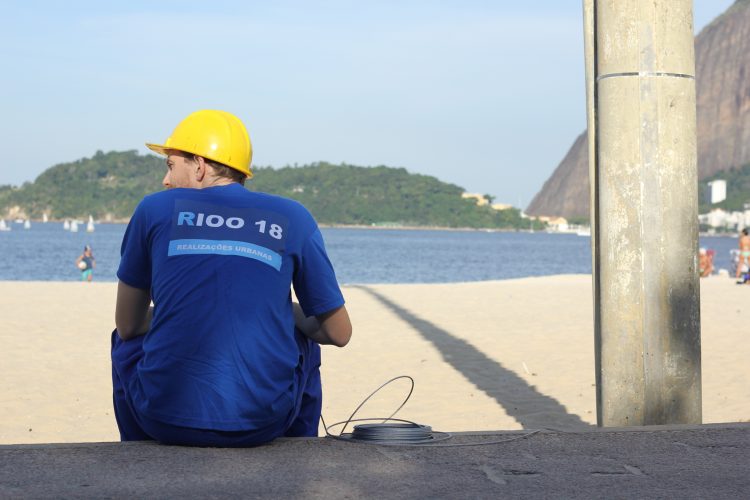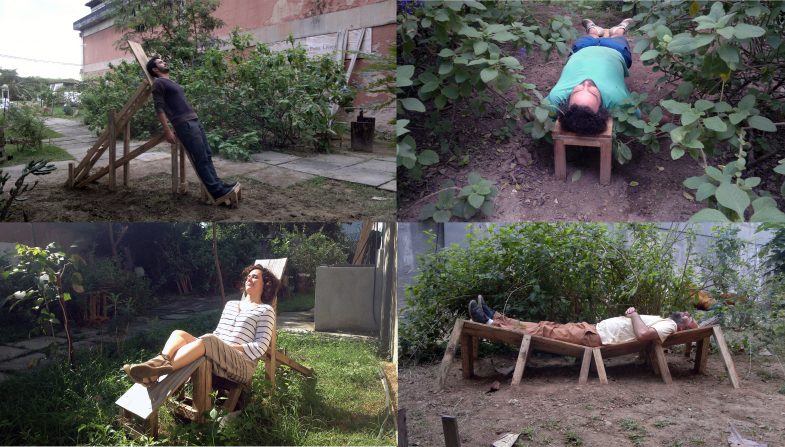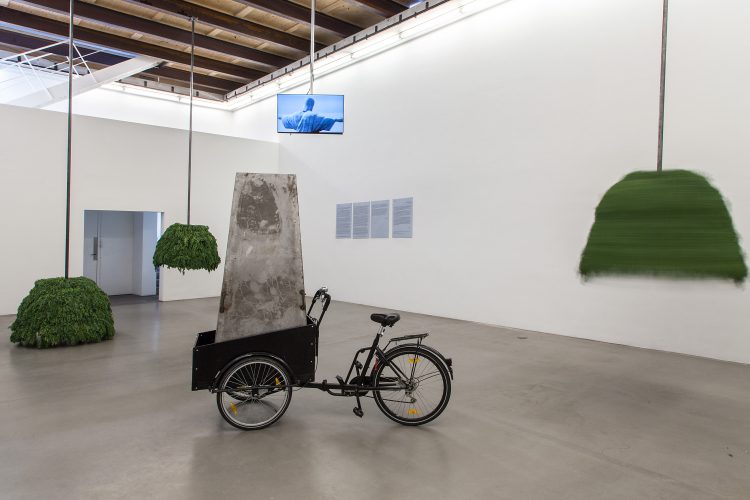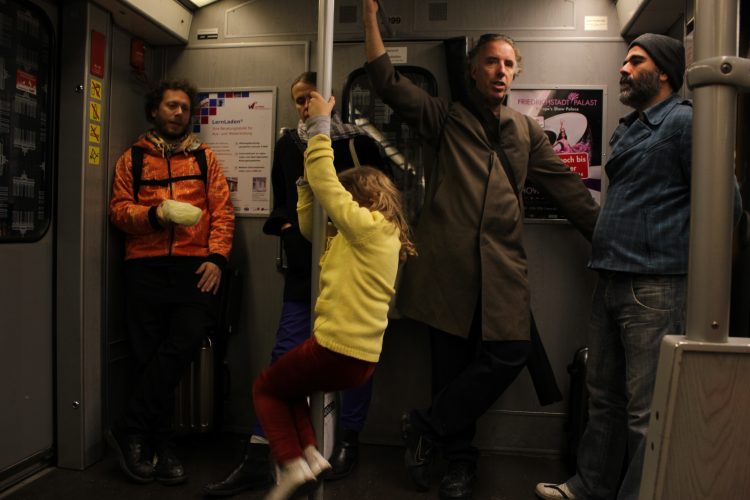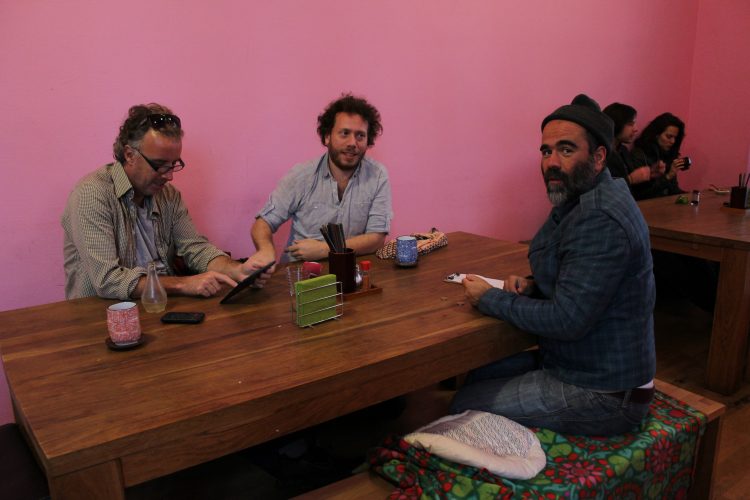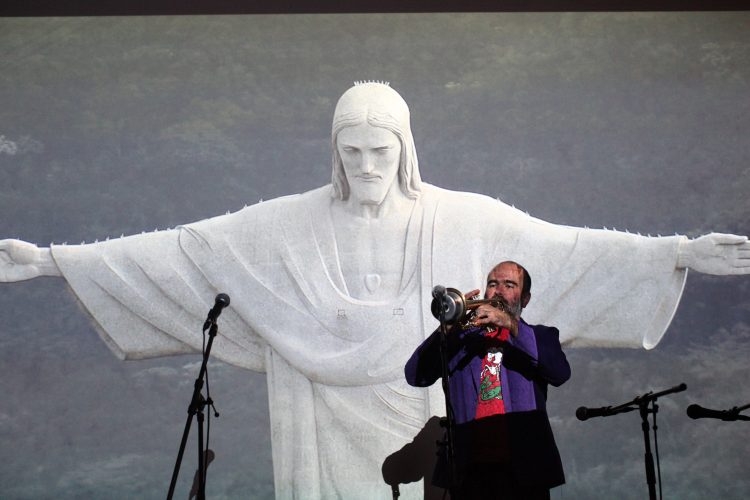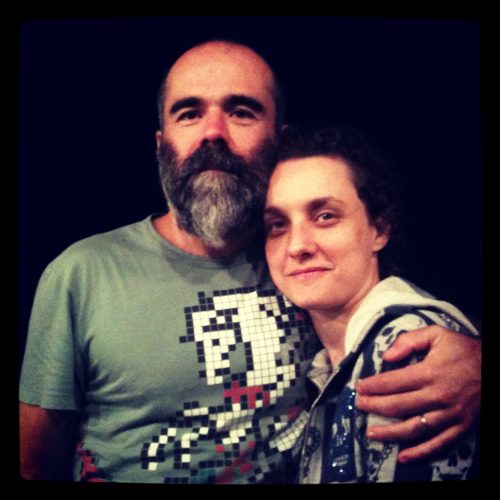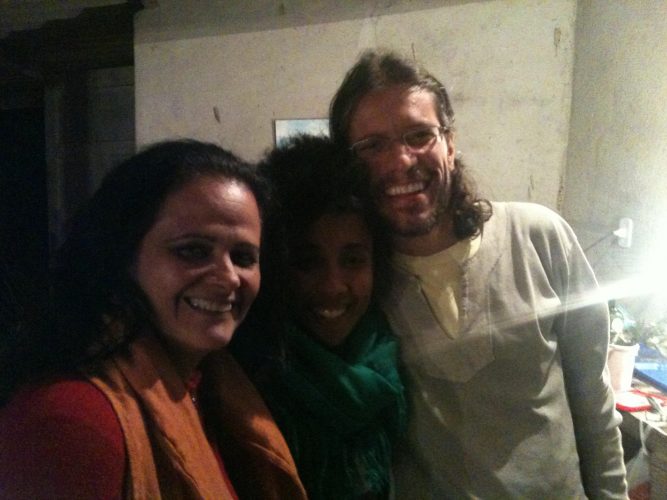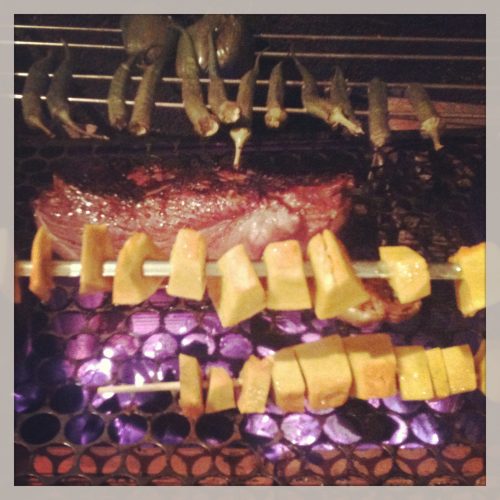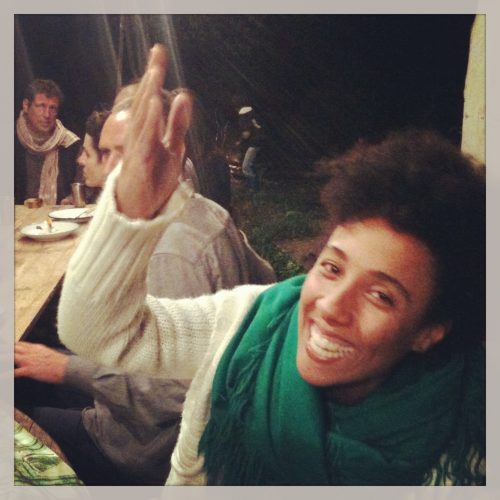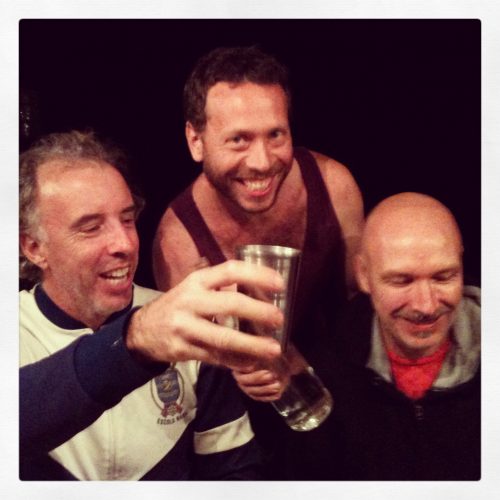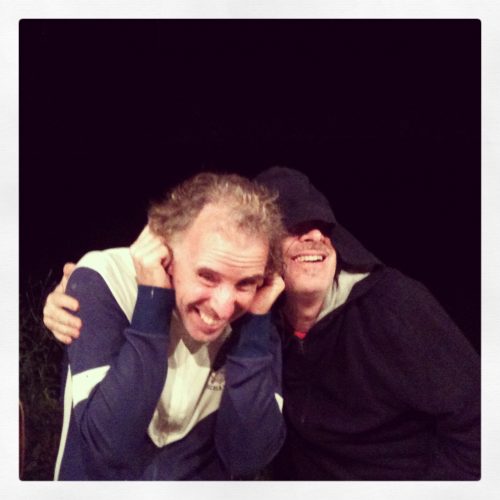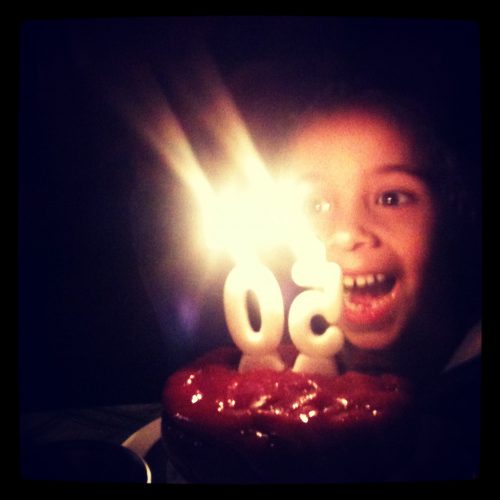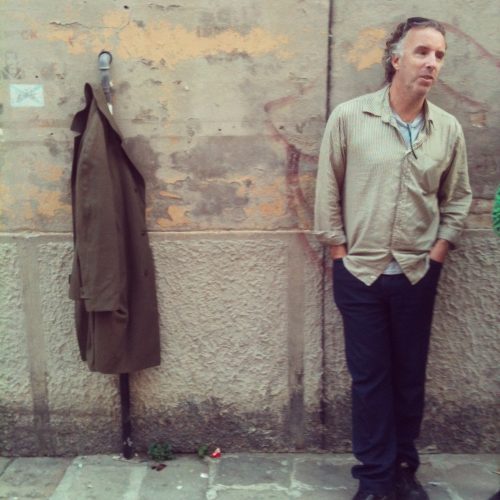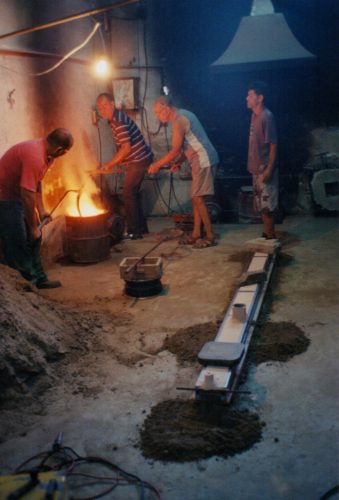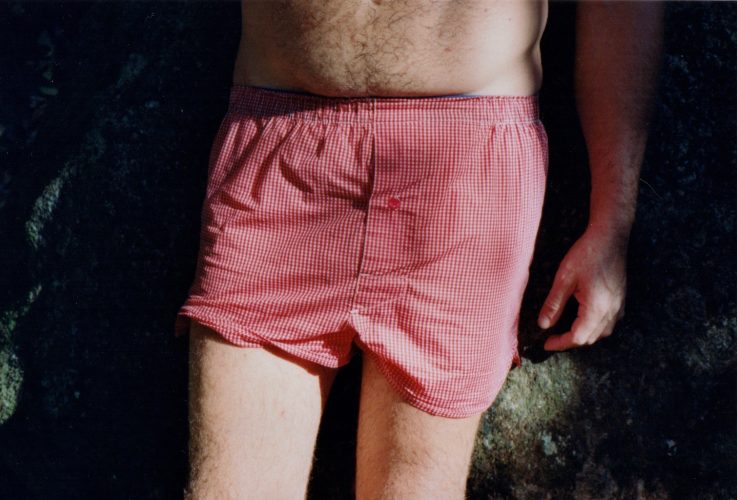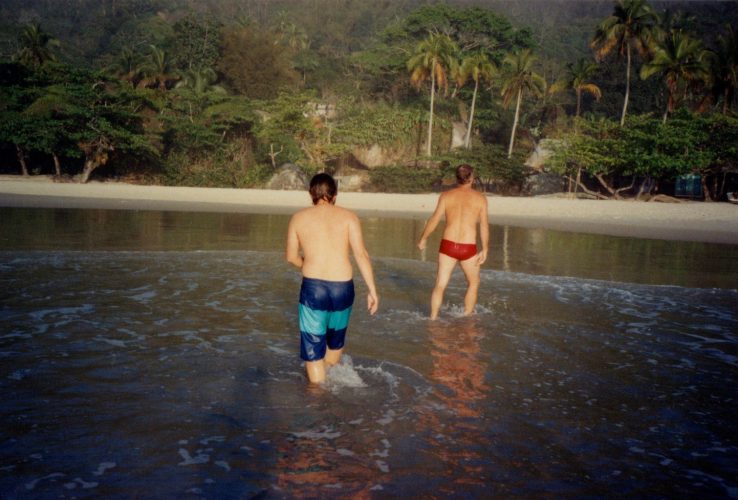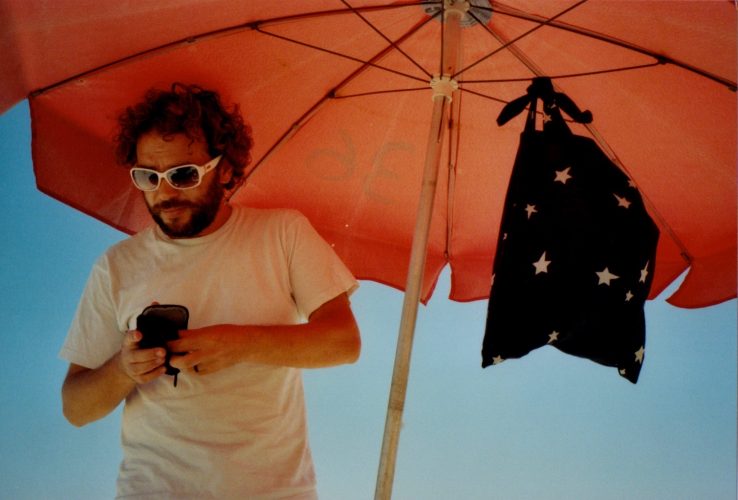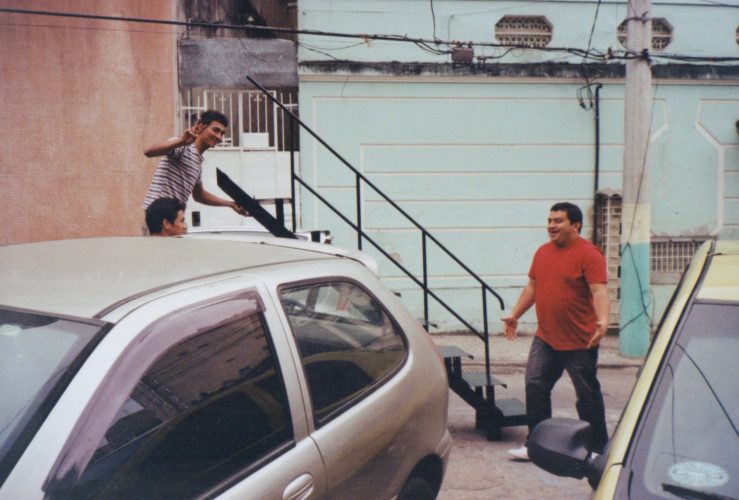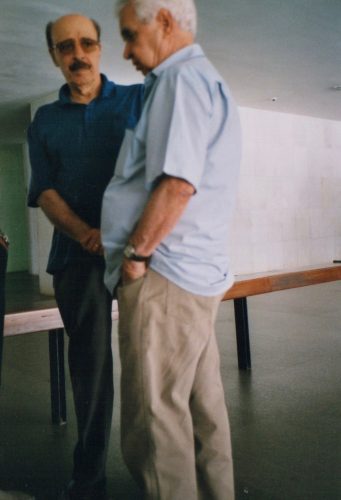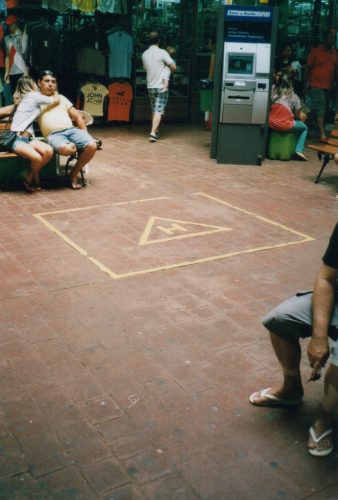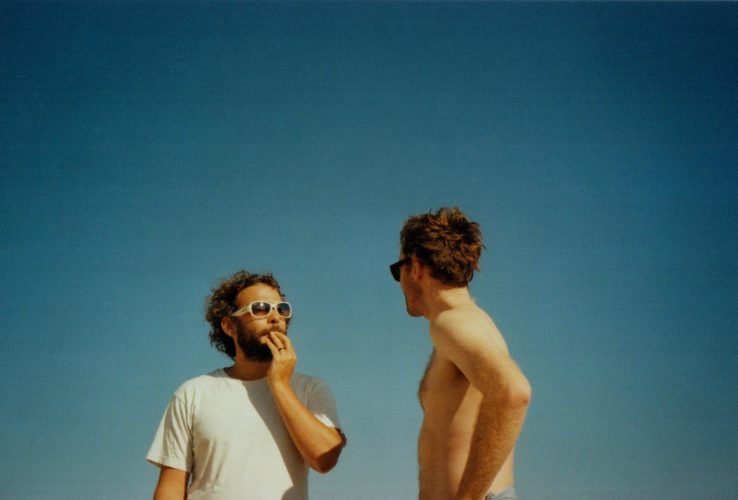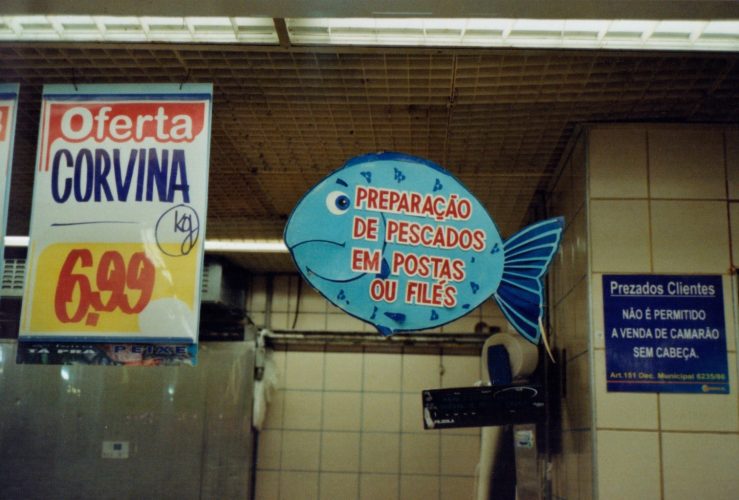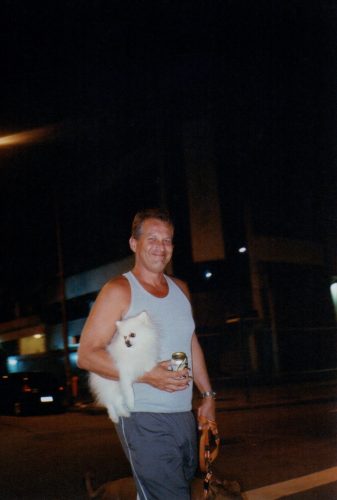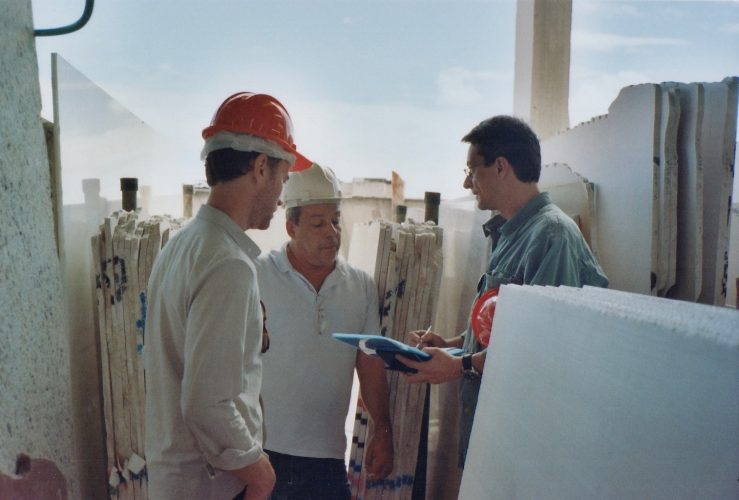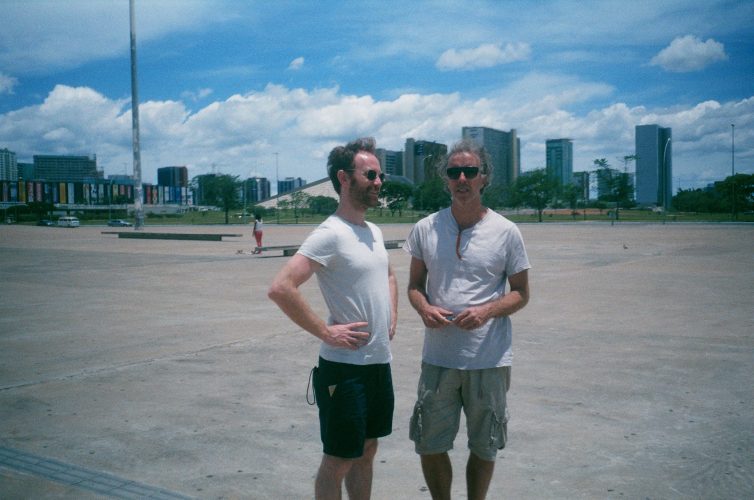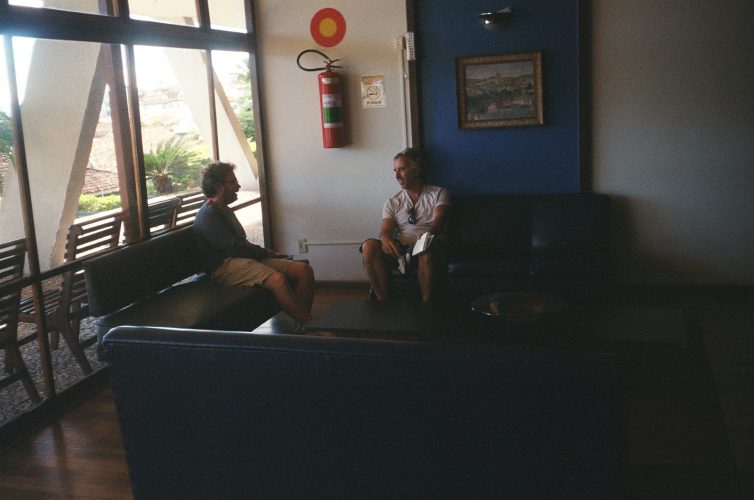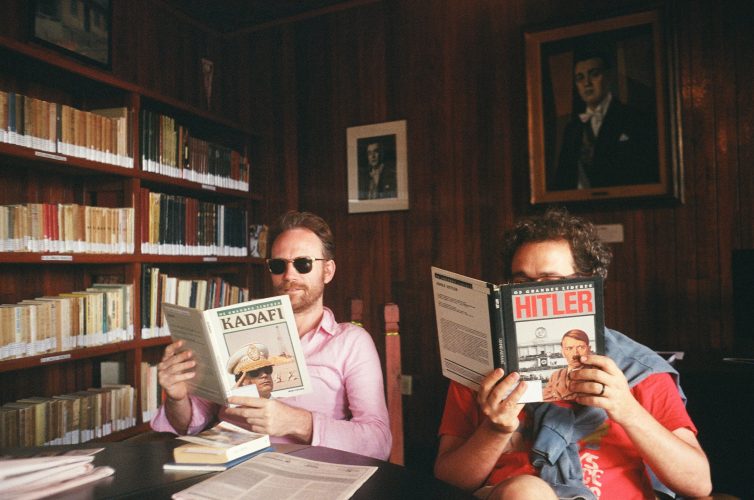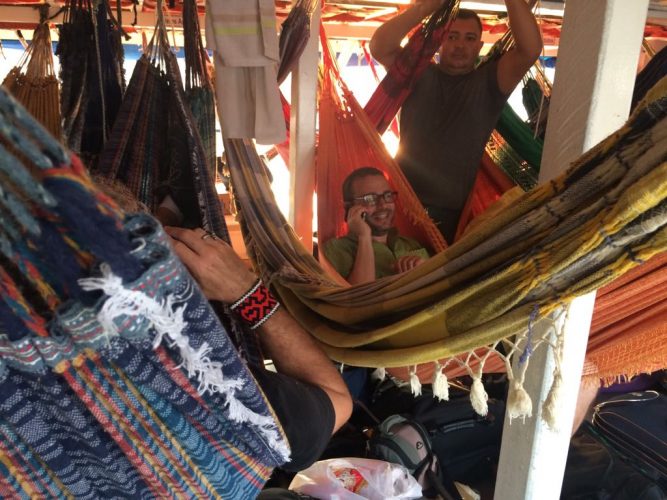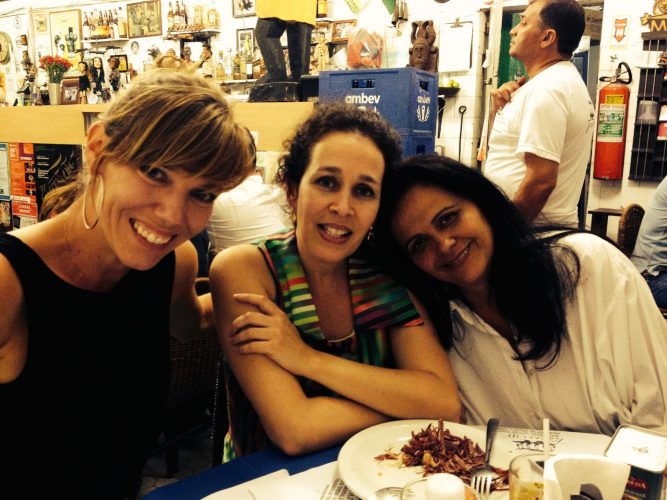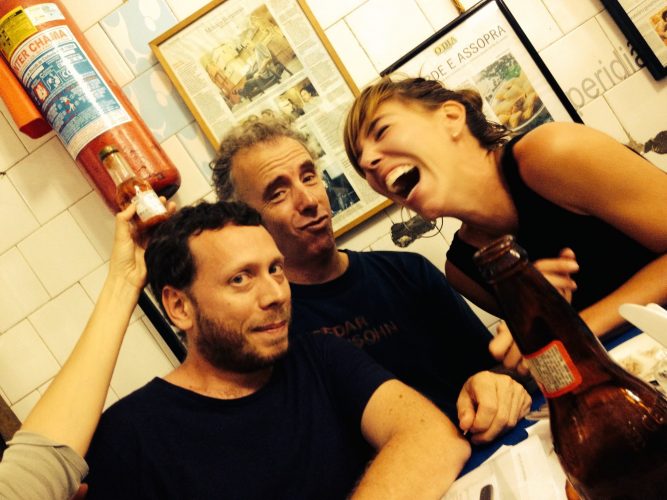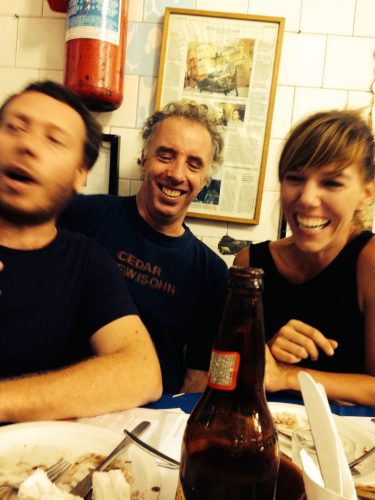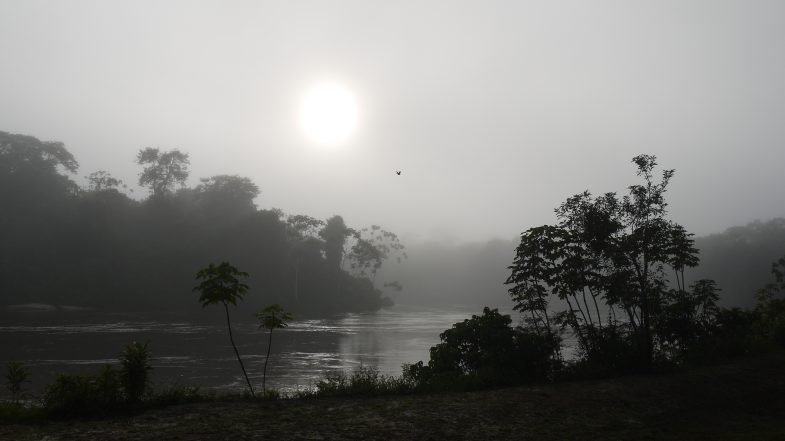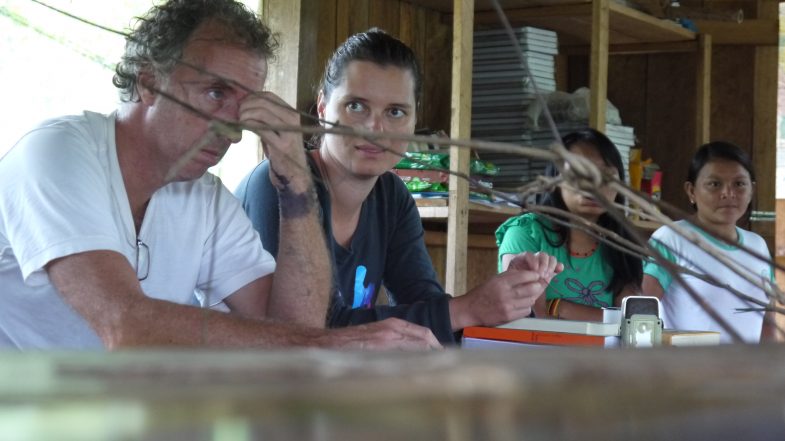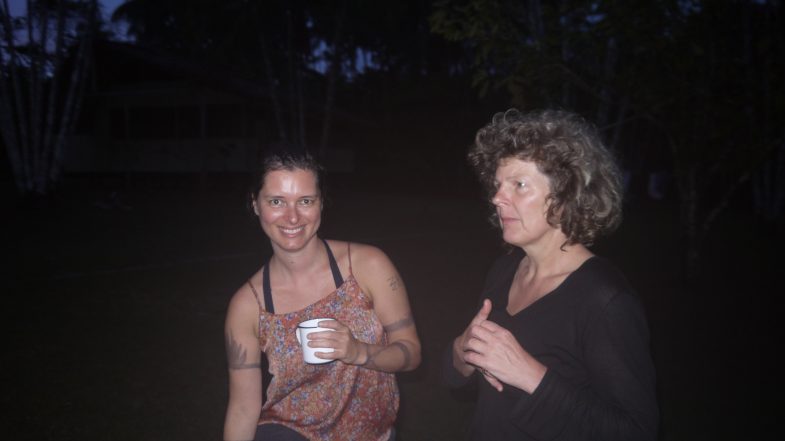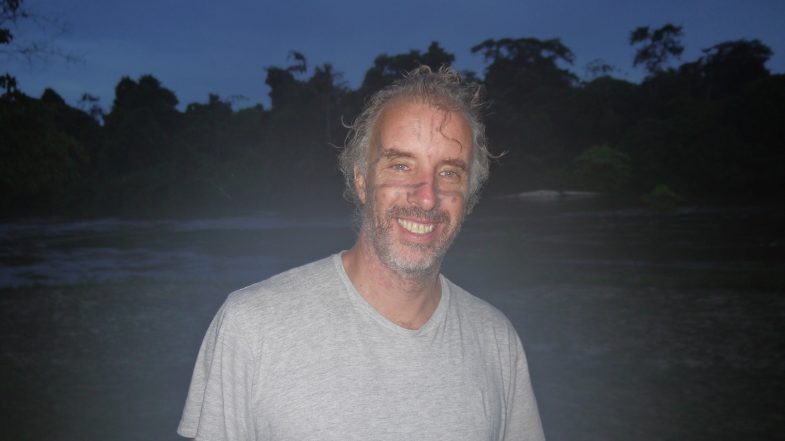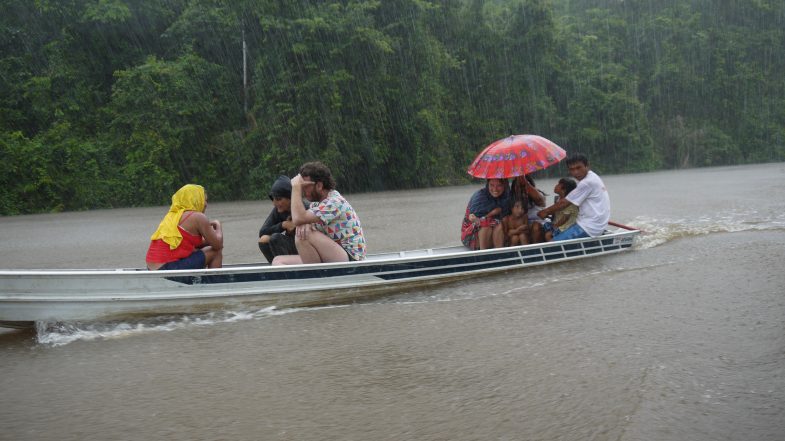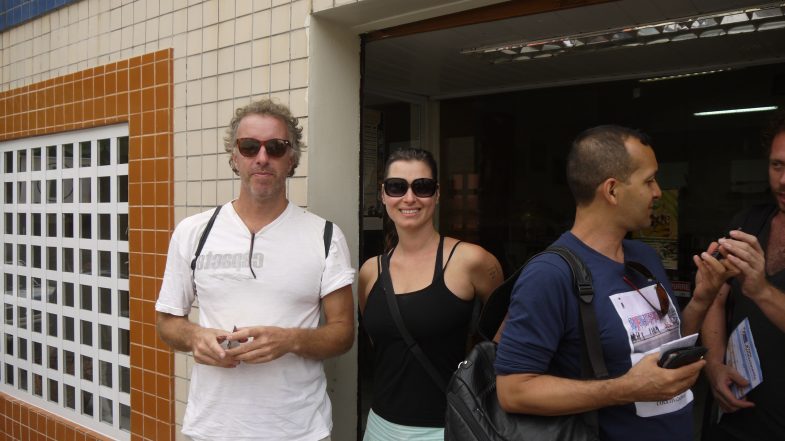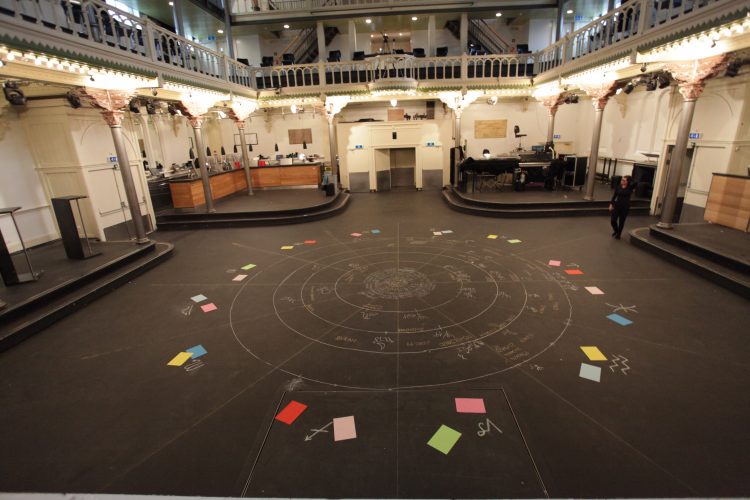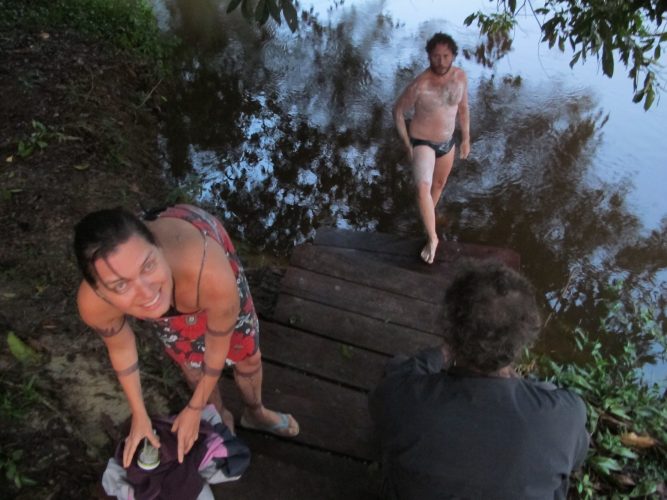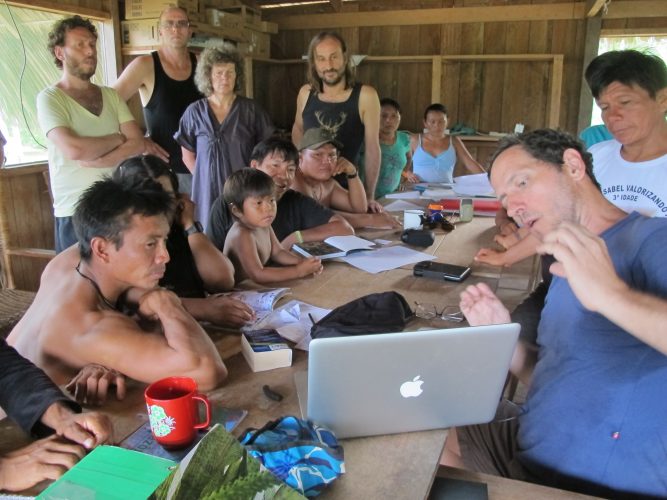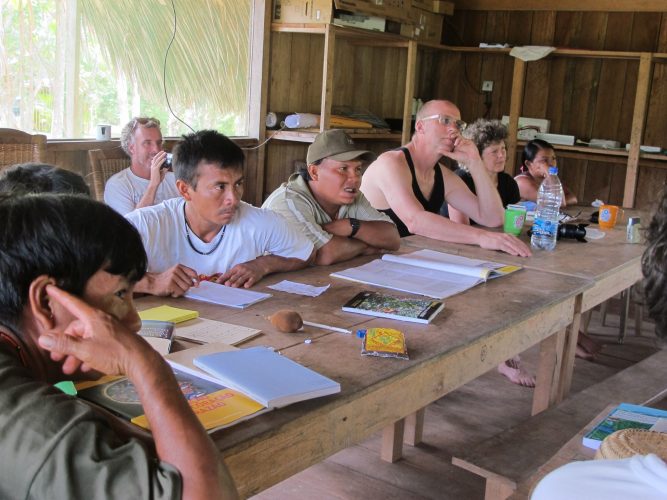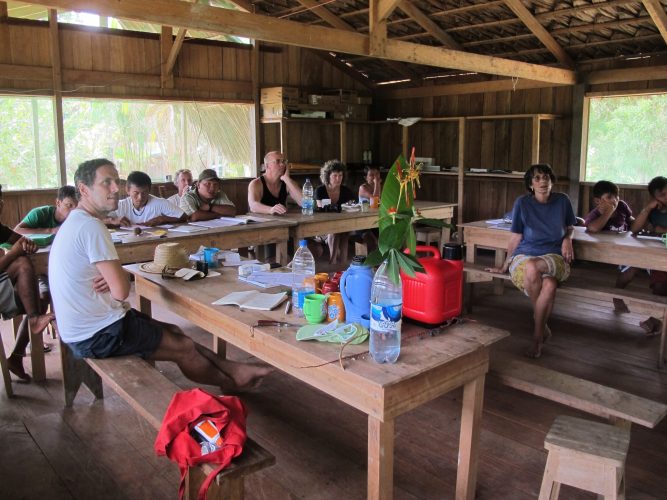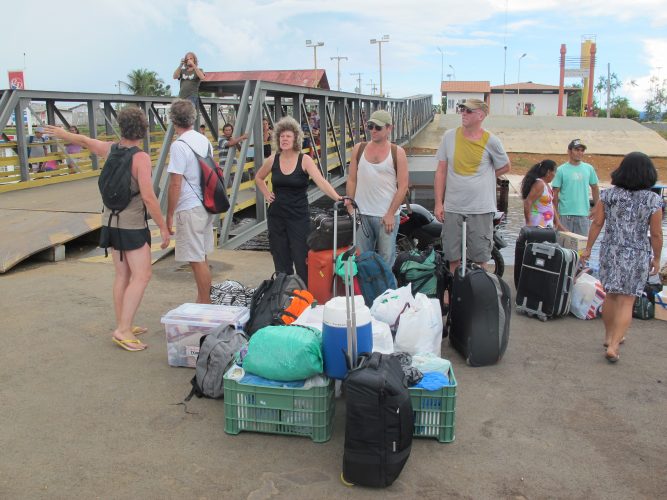Yael Davids is an artist born in Israel who lives and works in Amsterdam. She studied Fine Arts at the Gerrit Rietveld Academie, Sculpture at the Pratt Institute, New York and Choreography and Dance Pedagogy at the Remscheid Academie. Her works are predominantly performance-based, sometimes involving herself as performer at other times working with groups.
Rieke Vos
Annick Kleizen
“My residency at Capacete came as a crossroad: I arrived in Rio de Janeiro at the start of an independent practice after working as a curator for art institutes for several years; Capacete itself was going through a change of structure and brainstorms on (alternative) education and the new program were an ongoing conversation; above all, it was my first travel to Latin America. The three-month residency turned into a five-month stay and many subsequent returns to Brazil, mainly to São Paulo. During the first weeks, I wrote to a friend that Brazil taught me about complexity. At that moment this was not more than a hunch: I understood little Portuguese and my (Western European) perspective was only starting to open up. Since that first moment, the complexity only increased. Now I think that time in Brazil has been teaching me to listen more deeply.
+ Capacete’s focus is on presence, instead of studio-work, and there is no pressure to immediately turn time, conversations, walks and study into a fixed, presentable shape. Because of that, the experiences have the possibility to take their course and run much deeper. For me, those first months in Rio gave me a first taste of other narratives, and other ways of being in the world, that now, four years later, I still find myself working and thinking with.” -
GIA
A Residência, a Rua e os Encontros
“A primeira intenção tinha um sentido místico, sem necessariamente apelar para o lado religioso, mas achamos por bem fazer uma moqueca baiana para iniciar a residência no Capacete naquele ano de 2013. Rua do Russel, 300, nosso endereço por dois meses: o QG[1] da Glória. Foi ótimo, pois significava bom presságio. A cozinha da casa havia nos aceitado e isso, para nós, é fundamental, já que possuímos uma forma bem definida de criação em que a culinária ganha status de burocracia e a cozinha de escritório. Essa maneira de operação de ideias tem nos acompanhado desde que nos conhecemos por GIA. + Mandinga conceitual realizada, os louros começaram a aparecer. Em função do projeto de um grande amigo, iniciamos a residência com uma experiência de ordem culinária. É necessário dizer que, além da comida, a amizade é um elemento importante para o processo de criação do GIA. Organizou-se na casa o projeto cozinha internacional, no qual todas as quintas-feiras à noite recebíamos grupos de artistas, arquitetos, desocupados necessários, dançarinos amadores e comilões de natureza para saborear quitutes de todo o canto do mundo, além de conversar sobre tudo. Os jantares eram importantes, pois ressaltavam o conceito de convívio e de estar juntos que pensávamos no contexto da residência, ideia que continuamos levando adiante. Residir, morar, cuidar. Pode parecer estranho para um grupo que tem a rua como suporte de realização dos seus trabalhos de arte, mas esse ponto de vista não tem procedência. Sempre usamos o espaço casa como local de criação, sempre em volta do fogão, com muito samba e amigos e não poderia ser diferente no Rio, pooorra! As ações são para a rua, a lapidação de sua execução: a cozinha. Será necessário falar, adiante, sobre as ações que estavam sendo realizadas naquele momento – apesar deste pequeno texto desejar tratar do conceito de residência, de um lugar mais aconchegante e afetivo. Sendo assim, nosso processo de absorção foi muito orgânico em relação ao dia a dia de moradores e não de turistas. Foi fundamental o reconhecimento da vizinhança mais próxima, pessoas que já interferiam no dia a dia da cidade, como o entregador de água que produzia vídeos – Fala My Brother -, a feira de orgânicos da frente do prédio que chutava a canela de modelos menos inteligentes de postura alimentar. A identificação que os nordestinos tinham conosco, e assim foi… Coisas da vida, que iam acontecendo num fluxo contínuo… Viva Batatinha! Falando em Batatinha, não precisou andar muito para dar samba. Na mesma praça da feira de orgânicos topamos com uma roda, Sambastião, por causa do padroeiro e da estátua instalada na mesma praça, bendita moqueca! O GIA, desde sempre, articulou táticas e fazeres multifacetados para dar visibilidade e comunicar – comunicar no seu significado primário, no sentido de tornar comum determinada mensagem, a comunicabilidade antes da comunicação – seus enunciados, construir e partilhar suas narrativas em meio às brechas e fissuras do tecido urbano, de maneira inesperada, atuando nas rotas desviantes do improvável. Dessa maneira, durante os dois meses de residência no QG da Glória, foi possível refletir e discutir sobre o Choque de Ordem que atingia a população da capital carioca naquele momento, e maneiras potentes de criticar seus desdobramentos. O GIA, então, declarou em seu blog: Podemos destacar a violência que o termo carrega: “choque”. Triste analogia ao cumprimento da ordem via choque elétrico, cada qual que faça sua comparação. Fora do campo da linguagem, a violência continua sendo uma premissa, em vários aspectos, sobretudo contra a população de baixa renda, ou seja a maioria. Os interesses deste choque de ordem são bem explícitos[2]. A conclusão do grupo foi assertiva: Choque dói. Diante dessa constatação, o GIA achou necessário espalhar pela cidade essa mensagem, formulando uma espécie de campanha não oficial. A marca da prefeitura do Rio de Janeiro, então, teve seus elementos alterados – num típico détournement situacionista – e foram produzidos dezenas de adesivos (em uma produção caseira de serigrafia realizada na residência), colados em diferentes locais da cidade. O adesivo laranja se camuflou perfeitamente nas lixeiras cariocas, permanecendo ali como um parasita, disseminando uma contra-informação[3] por tempo indeterminado, em meio à contingência urbana. Fica claro, então, que grupo desejava se articular no contra-fluxo da imagem consensual que permeia o Rio de Janeiro, cidade maravilhosa: capital do carnaval, das praias, do turismo e do lazer. Percebendo que nem tudo era tão maravilhoso assim, o GIA, passeando pela cidade, também colou em locais específicos adesivos com a mensagem Do not take a Picture (Não fotografe), com intuito de chamar atenção para áreas degradadas e invisibilizadas na capital carioca. As mensagens sinalizavam pontos de tensão, operando desvios e pequenos curtos-circuitos na concepção aparentemente unânime do “Rio de Janeiro Cidade Espetáculo”. Voltando à residência: já estamos acostumados a experiências de convívio criativo. Aliás, desde o nosso QG do Santo Antônio, em Salvador, a nossa residência na Bahia, a amizade é realmente primordial para a amálgama do grupo. Fator que, de alguma maneira, tornou a residência no Capacete redundante. Não esperávamos – será que alguém esperava? – algo diferente do que já somos: a residência propriamente dita e as intervenções nas ruas como continuidade de nossa vida cotidiana, uma sintonia de nós com a casa e simultaneamente com os espaços heterogêneos que compõem a cidade. O QG da Glória: uma excelente biblioteca, uma vista maravilhosa, ressaltando uma belíssima árvore, que rompe com a gravidade e nos olha no fundo dos olhos, se coloca na mesma altura de nossos seis andares. A cozinha dispensa apresentações. O resto não importa, mas sem dúvida merece elogios. Impossível dizer quantas pessoas passaram por lá − o mesmo pode-se dizer do QG da Bahia. Sendo assim a mais crua realidade é melhor dizer: estávamos em casa. [1] O QG – Quartel General- é um espaço de encontro, pensamento e ação, trabalho que já foi realizado pelo GIA em diversos lugares. O trabalho consiste na produção de um espaço temporário no qual os artistas convivem com o público, propondo instantes de partilha e convívio – através de refeições compartilhadas, troca de ideias, disponibilização do acervo do grupo, festas, rodas de samba – sendo que muitas ações e intervenções surgem desses potentes momentos de convívio. Dessa maneira, a participação do público é de fundamental importância para a realização do QG, que assume diferentes configurações a depender do lugar onde se desenvolva: plantas, instrumentos musicais, lona amarela, comida e afeto são alguns dos elementos que compõem o QG do GIA. [2] Disponível em: http://giabahia.blogspot.com.br/ [3] Para o artista visual Cildo Meireles, uma contra-informação é aquela que circula por circuitos alternativos, descentralizados, que se opõem às mensagens veiculadas pelas mídias oficiais, como televisão, rádio, jornais, etc. -
Paulina Silva Hauyon
Paulina Silva has a degree in Visual Arts at the Universidad Finis Terrae in Santiago de Chile and Master in Art Research and Creation of the Complutense University of Madrid, Spain.
“El año 2013 fui seleccionada para participar en la Universidade de Verão en Rio de Janeiro, instancia que me dio la oportunidad única de participar de un contexto interdisciplinario que incentivó un dialogo abierto y horizontal fomentando otros modos de relacionarnos, trabajar y vivir. A través de esta experiencia, pude notar que la Universidade de Verão por medio de sus metodologías y contenidos, genera una suerte de optimismo crítico, otorgando la posibilidad de acceder a nuevas herramientas analíticas y prácticas para interpretar y construir la realidad. Asimismo, dada mi experiencia vivida en la Universidade de Verão, destaco el espacio que Capacete otorgó a los momentos de esparcimiento compartidos, y la posibilidad de generar lazos afectivos como resultado de la convivencia activa con los otros.”
Patricio Gil Flood
Currently living in Genève, Switzerland. I studied in UNLP, Argentina, and ECAV, in the Master of Arts in Public Spheres program.
“Since some years from now, I’ve been carrying a practice questioning the notions of work and leisure in arts. And I have been participating in a number of projects that confront the relation between text (writing, archive research, etc) and action (performance, publishing, etc). There are existing tensions between visibility and invisibility, questioning the work (of art) and its documentation (or existence). Now these aspects are taking a form of a research in the itinerant project called ECOLE DU NON TRAVAIL (http://www.ecoledunontravail.org). + Also during the last years, I have been participating collectives experiences related to performance, collective associations, walks and discussions, institutional interpellation, experimental exchange of goods, historically migratory traits and drifts. Some examples are: MACACO Press, an publish deviant project running with Sabrina Fernandez Casas, based on strategies of legal and illegal productions, actually based in Genève: http://www.macacopress.ch Some other examples of collective work participation are Los Individuos Radio, La Dispersión, AAS (Agencia de Asuntos Subtropicales), Artistas Orgnizados, Centro de Investigaciones Artisticas, and the micro society of artists Proyecto Venus. I went to Capacete in the summer of 2013 to the Universidade de Verao. I was living in La Plata at that moment with Paulina Silva Hauyon, and we both get accepted to this plan, so we went together to this residency. The year before we met Amilcar in an itinerant collective project we were participating, called Agencia de Asuntos Subtropicales, which was organized with Teresa Riccardi. She was who recommend us to apply to come to Rio, and was super prosperous her recommendation. For me it has been a huge personal experience, to get involved in an residency program that connects you with other context which is near but distant at the same time, but most to get involved in a kind of parenthesis, a time lapse that transported me, to involve my body, to involve my mind, in an open experience for discussion and sharing knowledge. Daniel Steegmann was in coordination and lots of presentations, in different ways were done there. There was a space for us to introduce some of our practice in the collective, but also there were conferences and lectures, and dinner, and informal talks, and visits, and tours, and nightlife, and cooking together. There were a lot of sharing moments, a summer atmosphere, the air was heavy and humid, but the energy was high. Aleta, Daniel, Fabio, Gabi, Gustavo, Kadija, Luisa, Luiza, Marcio, Raquel, Rita, Ricardo, Amilcar, Helmut, Manuela, Daniel, Paulina and me. There were huge rains, lots hours of beach, walks in the forest. In that frame, we had exceptional invited guest as Kaira Cabanas, Max Hinderer Cruz, Falke Pisano, Sergio Bruno Martins, and Amilcar also. Some conferences were about the process of exotisation, other about decolonization, other about the origin of capitalism, other about the self-experience of being an artist, other about molecular revolution. I was working at that time in collective experiences related to create links in the dispersion, at the CIA Centro in Buenos Aires, but also about the time and non-effective ways of work. By the end of the residency it was almost carnival in Rio… and everything was having sense. I have to say that this experience reaffirmed my interest in ways of collective research and sharing knowledge processes, to continue in a practice that implode the sense of imposed dichotomies like doing-not doing, material and immaterial, and origin-arriving. It was a wonderful process and a beautiful time that we’ve shared at Rio in that summer. -
Raquel Versieux
Vive e trabalha em Juazeiro do Norte CE e no Rio de Janeiro RJ | Brasil
“Do período que participei da Universidade de Verão no Rio de Janeiro, em janeiro de 2013, na casa na rua Benjamin Constant, lembro-me da chuva à tarde, e das aulas serem ali no quintal, um espaço muito familiar, que me lembrava sempre o quintal da casa onde morei na infância. No meio disso a gente compartilhava experiências diversas, e sinto até hoje uma conexão particular com xs colegas desse período, foi um momento muito pontual onde refletia-se sobre circuito de arte e apropriações, muito especial, formação muito importante.”
Daniel Jablonski
Daniel Jablonski is a visual artist, professor and independent researcher. His multifaceted output combines theory and practice to investigate the role of the individual in the construction of new myths and discourses of everyday life. His works have already been seen in solo and group showa in Brazil and abroad, notably at the Centro Cultural São Paulo, the Instituto Tomie Ohtake, the Museu da Imagem e do Som, SESC Vila Mariana, Sancovsky, Zipper and Bolsa de Arte galleries (SP), as well as at Casamata, Centro Cultural Sergio Porto and Centro Cultural BNDES (RJ), and at Torcuato Di Tella University (Buenos Aires). His writings, including interviews, translations, essays and critical reviews, can be found in literature magazines such as Serrote (Instituto Moreira Salles), art magazines Amarello (São Paulo) and Octopus Notes (Paris), but also in independent publications and academic journals such as Concinnitas (postgraduate studies in art – UERJ) and Poiésis (postgraduate studies in philosophy – UFF-Rio). In 2016 he won the #7 Salon of Artists Without a Gallery Prize (#7 Salão dos Artistas sem Galeria), handed out by Mapa das Artes (SP); and the prize of the #41 Salão de Arte de Ribeirão Preto with an acquisition of the work by MARP. In the same year he was also artist-in-residence at Lugar a Dudas in Cali, Colombia, a residency awarded to him by the Escola de Artes Visuais do Parque Lage (RJ), where he taught for four years. In 2017 he was also nominated to the PIPA Prize. He currently lives and works in São Paulo and teaches at MASP – Museu de Arte de São Paulo.
Marcio Junqueira
Marcio Junqueira (Feira de Santana-1981) é Poeta e Artista Visual. Mestre em literatura brasileira (UERJ/2009) com dissertação sobre Caio Fernando Abreu e a Contracultura. A partir de 2005, começa a desenvolver trabalhos em diversos suportes em torno de: subjetividade; homoerotismo; escritas de si; e autoficção. Edita a Antologia / Coleção Rabiscos e (juntamente com Clarissa Freitas , Lucas Matos e Thiago Gallego) o projeto multimídia Bliss não tem bis. Publicou, em 2015, seu primeiro livro solo LUCAS (Sociedade da Prensa/SSA). Entre os projetos que participou/colaborou, destacam-se: Campo Minado dos Afetos (MAC-fsa, 2015); Salões de Artes Visuais da Bahia – Edição Especial (MAM-BA, Salvador, 2014); multiplo#5: exposição de arte impressa (CCSP, São Paulo, 2013); Tomar coca-cola com você (CUCA, Feira de Santa, 2012/ Galeria ACBEU, Salvador, 2013); Universidade de verão (coord. Daniel Steegmann Mangrané, CAPACETE, Rio de Janeiro, 2013); XI Bienal do Recôncavo (São Félix, 2012). Desde 2012, trabalha com professor de Literaturas em Língua Portuguesa no campus XVIII da Universidade do Estado da Bahia (UNEB). Vive no Arraial d’Ajuda.
Gustavo Ciríaco
Como artista, tenho trabalhado de modo transversal entre as artes do espetáculo e as visuais, passeando com outros saberes, outros campos, outras vozes. Muitas vezes esse modo é através de pessoas, de outros jeitos de manipular o dia a dia, juntando potenciais, ferramentas e insights em como lidar com o tempo e o espaço. Tenho usado movimento, texto, vídeo, fotos, estruturas de exibição e apresentação, em obras-conversas onde o encontro é rei. Há para mim muitas miudezas, sensações furta-cores, sentimentos que nos fazem derivar por aí e mover, coisas que rearranjam nossos olhos e nossas memórias, a nossa própria presença mesmo nas biografias que carregamos. Gosto do que é material nas coisas, do sabor das situações, da sua poesia em derivação. Gosto do que cada obra faz brotar como possibilidade de mundo.
Anton Steenbock
Alexandre Vogler
Siri
Ao contrário do que normalmente se espera da música contemporânea brasileira, o artista sonoro SIRI, faz arte contemporânea, misturando, música, performance, instalação e vídeo-arte. Em seu trabalho de estréia, “Siri” (independente), de 2004, o músico levou aos palcos sua parafernália musical e encantou o público com seu inusitado instrumento: uma sucata de Fusca 69 com motor, latarias e capota. Uma verdadeira orquestra urbana.
Daragh Reeves
Daragh Reeves Leeds, U.K. , 1974 – lives in Brussels and Berlin
“Being at Capacete was and continues to be a source of great happiness, fun, adventure and camaraderie. Here art and life are very much intertwined. Rio’s own special madness is an art beyond art and provided a very healthy perspective on the limitations and strengths of frankly being a Gringo. It’s an experience that I carry with me and am always grateful for lucking into.”
Julien Bismuth
….
“I first met Helmut in 2006, with Jean-Pascal Flavien. He helped produce a performance of ours titled “Plouf.” The performance took place on two boats off the coast of Rio. The first meeting we had with him was at the beach in Ipanema. I came back to Brazil in 2012, to finally do the residency. I stayed a little over three months. I started learning Portuguese while I was there. Helmut, Amilcar, and I produced an evening of performances or interventions at a theater in Ipanema. I also started a project which I am still working on, and which has taken me twice to the Amazon. Yet the most significant thing that happened, that took place, during this three-month residency was something else, something harder to describe than an activity or an endeavor. + The time I spent in the residency was, in many ways, a break. A hiatus. Though I continued working while I was there, it was not only in a different place but in a different environment. A different atmosphere. And perhaps that’s as close as I can get to defining or describing it. To me, capacete is synonymous with something as simultaneously palpable and elusive as an atmosphere. Every time I return, I encounter a reality whose protagonists change but whose “feel” remains more or less the same. There’s a feeling of openness, of engagement, of trust and sympathy as well, which I identify with capacete. Not that capacete is isolated from the world and its problems, not that it’s in any way an escape, but rather that it opens up onto the world and its problems from within a space that operates differently and with different rules: rules of trust, sympathy, engagement, and openness. These rules are neither stated not even enforced, they are interpreted and discussed, altered and experimented with by each new constellation of visitors, residents, participants. In other words, what capacete inspires and develops is a desire to relate and to relate differently. It develops a sensibility or sensitivity to the other protagonists of our relationships, be they animate or inanimate, material or virtual. Capacete does all of this not by imposing anything on its participants, but rather, by simply inviting them to be both the caretakers and protagonists of its continuous social experiment, one whose strength resides precisely in the inherently fragile and porous nature of its boundaries. Capacete is not a helmet, it’s a tent, and like all tents, it can be pitched more or less anywhere.” -
Merel van Huellener
About us: Van ’t Hullenaar & Vis is an Amsterdam based interdisciplinary artist duo consisting of Merel van ’t Hullenaar & Niels Vis. Together they research the experimental boundaries of visual art through the execution of conceptual projects; moving between applied and autonomous, collaborative and solitary positions. Both teach at the Royal Academy of Art in The Hague and hold MA degrees from the Sandberg Institute in Amsterdam and the Piet Zwart Institute in Rotterdam (The Netherlands). Amongst others they have previously attended artist residencies at Capacete in Rio de Janeiro (BR) and the Skowhegan School of Painting and Sculpture in Maine (USA). They have formed several temporary collectives and collaborations with other makers like in their current projects The Man-Made History of Today, that had its pilot in Brazil in 2014 and The Artefact Time Machine, taking place in Athens (GR). In the past they have also taken on positions as mediators with for instance FLAT / BijlmAIR foundation and Gallery AWA in Amsterdam and they have presented their work in national and international contexts through numerous exhibitions, screenings, performances and lectures in art spaces, institutions and festivals like; Het Nieuwe Instituut (NL), Art Athina (GR), Holland Festival (NL) Largo das Artes (BR), Kalashnikovv Gallery (SA), Chicago Artist Month (USA), SMBA (NL), Hotel MariaKapel (NL), TENT (NL) and Galleria Comunale d’Arte Contemporanea, Bologna (IT).
Mariana Lanari
“I took part in Máquina de Responder, a program that happened in parallel to the 29. São Paulo Biennial in 2010/2011. After the end of this program, a few of us remained working together on a book. Two years later, in 2013, I went to a mobile residency in the Amazone. In this trip, I met Bik van der Pol, also residents at the time, and joined their master program at the Sandberg Instituut in Amsterdam. Since then I leave in the Netherlands. It was through Capacete that I moved to the Netherlands, where I live for 5 years. It’s a radical gesture to encourage artists to not produce work during the residence. It’s a permission to slow down and rather listen, observe, interact, beliving that whatever happens in these periods will inevitably produce result in the future. Capacete is a community of people it has the magic of making you feel part of it.”
